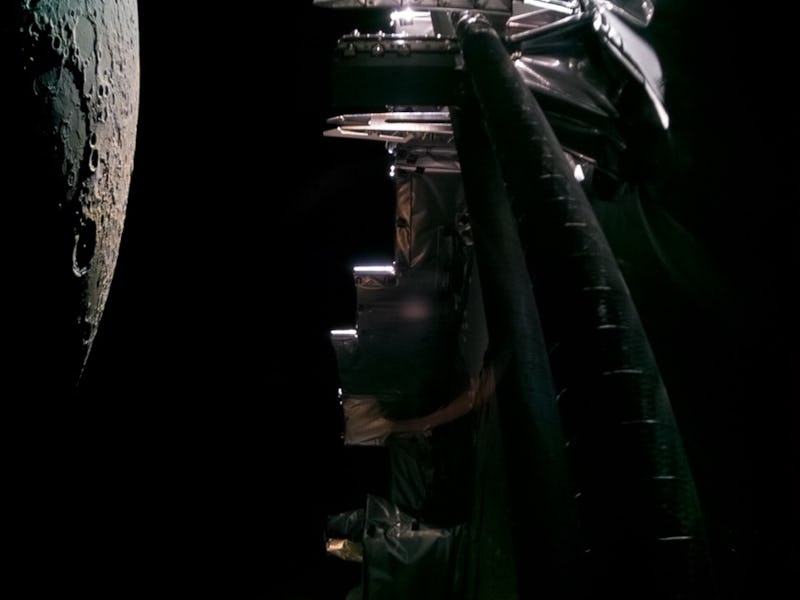Look! The ESA’s JUICE Spacecraft Just Performed A Daring Slingshot Around Earth
The high-resolution images aren't out yet, but these navigation camera shots are still pretty impressive.

A spacecraft bound for Jupiter just took a few snapshots of Earth as it slingshotted past its home planet. It’s next stop? Venus.
The European Space Agency’s Jupiter Icy Moons Explorer (JUICE) recently swung past Earth for a quick visit on its oddly meandering, but surprisingly fuel-efficient, route to Jupiter. JUICE breezed past the Moon on August 19 and Earth on August 20. In the process, the spacecraft’s camera and instruments took some quick images and measurements of Earth and the Moon.
JUICE’s onboard navigation camera snaps a quick selfie as the spacecraft flies past the Moon; the small blue blur in the distance is Earth.
Just Swinging By for a Gravitational Boost
JUICE’s August 19 flight past the Moon sped the spacecraft up just a smidgen (in orbital terms, a smidgen means about 2,000 miles an hour). That allowed it to move just slightly toward Earth, so our planet’s gravity could give it a tug; this slowed it down nearly 11,000 miles an hour. And that gentle braking from Earth’s gravity put JUICE in the right orbital path for a flyby of Venus next year.
Catching a direct flight to anywhere in the Solar System is almost impossible because it takes so much fuel to get there. If you were piloting a spacecraft and set your Galactic Google Maps to search for the most fuel-efficient routes to Jupiter, for instance, you’d end up with a weird series of loops around planets that seem completely out of the way — like Venus. That’s because each time your spacecraft flies close to a planet, the planet’s gravity tugs or pushes on the spacecraft, either slowing you down or speeding you up. And in space, your orbit around the Sun depends not on which direction you turn the steering wheel, but on how fast you’re moving, so changing your speed is the key to navigation.
By flying past the Moon and Earth earlier this week, JUICE got a couple of free changes to its speed and direction (engineers call this a change in velocity, or delta-V) without burning any extra fuel. Since fuel is heavy — and therefore challenging to launch in large amounts — most mission planners would prefer to take the long way around if it means saving fuel (unless there are humans on board). JUICE, for example, will fly past Venus in August 2025, then slingshot around Earth two more times, in September 2026 and January 2029, before finally reaching Jupiter in 2031.
This diagram shows JUICE’s complex route to Jupiter.
“Thanks to very precise navigation by ESA’s Flight Dynamics team, we managed to use only a tiny fraction of the propellant reserved for this flyby,” says JUICE spacecraft operations manager Ignacio Tanco in a recent statement. “This will add to the margins we keep for rainy day, or to extend the science mission once we get to Jupiter.”
One possible use for that saved fuel could be a closer approach to Jupiter’s icy moon Ganymede.
Snapshot of Home
During the recent flyby, JUICE passed about 4,250 miles above southeast Asia and the Pacific Ocean, and the mission team took the opportunity to capture some high-resolution photos of Earth and the Moon with the spacecraft’s JANUS science camera. JUICE’s 10 science instruments also collected some data as the spacecraft flew by the Moon and then Earth. Those measurements were mostly a test of the spacecraft’s instruments, to help its team on Earth prepare for the real mission at Jupiter.
“Given how well we know the physical properties of Earth, the Moon, and the surrounding space environment, it’s also the ideal location to understand how the instruments respond to a real target,” says JUICE operations scientist Claire Vallat in a recent statement.
The ESA plans to release the data, and the high-resolution science camera images, in the next few weeks. In the meantime, images from JUICE’s navigation camera are already available.